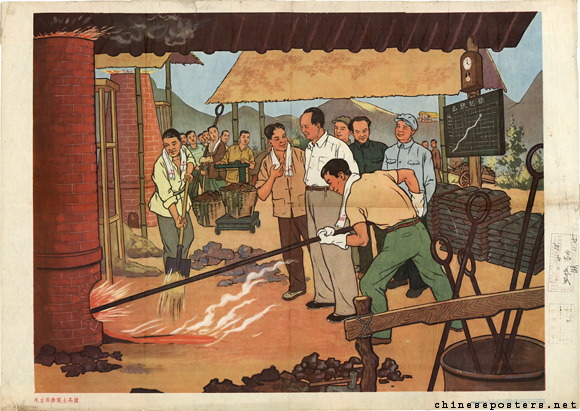What were the dates of the Second Five Year Plan?
1958-1961
What did cooperatives become?
communes/collectives
What was the first focus of the Great Leap Forward (industry)
Grain Production
What was the first problem with the communes?
The "iron rice bowl, a reference to the fact the food source is never broken" (Sowdon,p.169).
Because the communes were built on collective efforts, you still be fed if you did less work than your friend (hint: this is not a good thing)
What was the broad aim of The Great Leap Forward?
To develop the rural economy after the lack of development during the First Five Year Plan, and to modernise China.
Why did the shift occur? (hint: attitude of some officials to bureaucracy)
Mao believed regulations "held back the creative forces of the masses" (Ryan, p.183), and that by establishing communes instead of cooperatives, in which things like communal kitchens, laundries and similar were intended to "free labourers for work in the field" (Sowdon, p.169).
Why was the first focus (industry) important?
To boost industrial production, by using profits to fund industrial expansion.
What are some of the features of the commune?
-collective ownership and farming of land (no private plots)
- small land plots were combined into massive sites that were tilled by hundreds and even thousand of workers at a time
-tools, livestock, and other similar possessions became collectively owned
-instead of wages, people received work points to use for buying clothing and everyday items
(Ryan, p.185)
- A typical commune averaged 10,000 acres of arable land with collective responsibility for 100,000 livestock (Gates and Morgan, p.173)
- People required special passports to travel between communes (Gates and Morgan, p.172)

Backyard steel furnaces, which ultimately failed as a economic project.
This campaign impacted future campaigns, as household tools were used to feed the furnace fires, and melted to try and create steel.
By the end of 1958, what is the estimated number of communes?
Over 26, 000 operating (Sowdon, p.169) (Ryan, p.185)
What speech did Mao make at the 40th anniversary celebration of the Russian Revolution in Moscow? (November 1957)
Mao declared that the "east wind prevails over the west wind", and that in 15 years China would overtake Great Britain in steel production (Ryan, p.182)
what were some problems with work points?
Everyone received the same points, based on their category of worker.
There was no change based on age, or disability, and you did not receive bonus for working more hours than anyone else; you could not change your points.
Similarly, if you were assigned a project that took longer than another group, you did not receive more points.

"Eliminate the 4 Pests!"
"From 1956 onwards, mice, sparrows, flies, and mosquitoes should absolutely be eliminated in all possible places within 12 years. Killing sparrows serves to protect crops. Sparrows in cities and forest areas do not necessarily have to be eliminated. " January, 1958.
A campaign attempting to stop these animals from eating grains and crops that were desperately needed so that steel production could be boosted.
What was the average structure of a commune?
"Averaged 5000 households, with populations of up to 100,000 people" (Ryan, p.185)
"Twelve families would make a 'work team' [in the commune], with 12 work teams making up a brigade" (Sowdon, p.169)
What happened to the sparrows?
Sparrows were almost completely eradicated, which meant that the bugs (like locusts that also ate crops) that were usually controlled by the sparrows became a deeply signifnanct ecological problem.
Mao later removed sparrows from this campaign and replaced them with bedbugs.